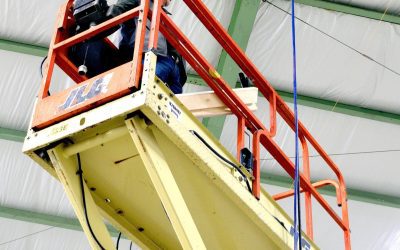HAZWOPER for Aerial Lift Operators: OSHA Safety at Height
HAZWOPER Training for Aerial Lift Operators: Safety at Heights Around Hazardous Materials
Introduction
Aerial lift operators often work high above the ground in places where chemical fumes, vapors, or overhead hazards are present. Whether you’re repairing piping in a chemical plant, performing electrical work near exhaust vents, or painting with solvents, there’s a real risk of exposure to hazardous materials. That’s why OSHA requires specific safety training known as HAZWOPER—Hazardous Waste Operations and Emergency Response.
HAZWOPER training teaches aerial lift operators how to identify chemical risks, use the right PPE, and respond safely to spills, fumes, or leaks. It also complements OSHA’s fall protection and lift operation standards (1926.453 and 1910 Subpart F), especially in chemical-heavy environments.
Why Aerial Lift Operators Need HAZWOPER Training
When working at height, even minor exposures to hazardous materials can quickly become serious. A leaking pipe, flammable vapor, or airborne particulate near a lift platform puts the operator in direct contact with danger.
HAZWOPER training helps operators:
- Spot chemical risks from overhead ducts or tanks
- React to emergency leaks or spills while elevated
- Wear PPE correctly, including respirators and face shields
- Understand safe movement near hazardous work zones
- Follow decontamination and evacuation protocols
Which HAZWOPER Course is Right for You?
Training depends on your level of exposure:
- 40-hour: For workers who regularly work in hazardous areas, like tank farms or chemical plants
- 24-hour: For those with occasional exposure to hazardous processes
- 8-hour: For refresher training or workers in lower-risk but proximity-based roles
Hazards to Watch for in Elevated Work Areas
When working from an aerial lift, hazards can be harder to see or escape from. Common risks include:
- Fumes from nearby tanks, vents, or ductwork
- Paints and solvents release VOCs near your work zone
- Exposure to pressurized pipes or corrosive mists
- Overhead leaks or spills from storage containers
- Inadequate airflow at height
Knowing how to spot and report these dangers is key to preventing serious injuries.
PPE for Aerial Lift Operators Around Hazards
When you’re working off the ground, you need gear that protects you from both chemical and fall hazards:
- Full-body harness with proper anchorage
- Chemical-resistant gloves and suits for overhead exposure
- Goggles and face shields to block splashes and fumes
- Respirators for poor ventilation or vapor-heavy zones
- Non-slip boots with chemical resistance
Final Thoughts
Aerial lift operators face unique challenges when working near hazardous materials. The higher you are, the more important it is to be prepared. HAZWOPER training gives lift operators the knowledge and tools to stay safe, act fast in emergencies, and reduce long-term exposure risks.
From maintenance jobs to industrial painting, working smart at height starts with understanding the hazards around you—and having the right training to handle them.
